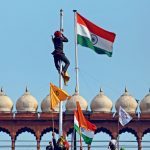The Lies of the Land
The popular arguments in defense of the development models of Kerala and Gujarat are of dubious merit.
 Shanu Athiparambath
Shanu Athiparambath
 Shanu Athiparambath
|
07 Sep, 2012
Shanu Athiparambath
|
07 Sep, 2012
/wp-content/uploads/2015/11/land.jpg)
The popular arguments in defense of the development models of Kerala and Gujarat are of dubious merit.
Kerala is the most “socially developed” Indian state. It is also the state where mothers used to tuck their children into bed whispering the punishment for bed-time resistance. All it took to put a baby to sleep was a warning: “I will hand you over to communists.” Kerala is yet to go through an Industrial revolution. Yet, Kerala has the highest life expectancy and the lowest rates of malnutrition, and infant and maternal mortality among Indian states. It also has the highest literacy rate. In the United Nation’s Human Development Index, many developed countries are no match for God’s Own Country. Perhaps, it is true that the Harvard researchers who visit Kerala are convinced that this is the pinnacle of civilization.
Some think it to be a paradox. But, many believe that the “Kerala model of development” is a vindication of man’s desire to be placed in a cradle where all his needs are met. Even as a worldview, it feels so good. The security of the cradle, however, is tempting only to a pampered baby who has turned too lazy and difficult. Otherwise, a frown appears on its forehead. But, this is nothing to worry about. The cradle seems to exist and function-precisely because of this.
Many intellectuals attribute Kerala’s ‘success’ to its radical leftwing politics, matrilineal system and literacy campaigns that date back to the early 19th century. It is believed that government investment in education, healthcare and basic necessities laid the foundation of progress in Kerala. But governments heavily subsidise education and healthcare throughout the world. The supposedly enlightened voters of Kerala were often ruled by people who even opposed computerisation. Their policy positions are a complete rejection of centuries of economic analysis. Is it plausible that their intuitions are sounder than science?
DEVELOPMENT WITHOUT FREEDOM
The states of Gujarat and Kerala have for long had a certain cachet as standout examples of development, the first for its supposed economic strides and the second for social development. Gujarat’s reputation as a showpiece of development has received a setback after the Gujarat Chief Minister Narendra Modi flippantly dismissed the findings of the National Family Health Survey (NFHS).
According to NFHS 2005-2006, 52 per cent of the children in Gujarat are stunted, in comparison to 25 per cent in Kerala. Modi admitted in a controversial interview with the Wall Street Journal that the health indicators of Gujarat were troubling, but he tried to explain it away by saying that in a middle-class state, women are more beauty conscious than health conscious. It is true that in developed countries, income and obesity are negatively correlated, but this is simply not true of developing countries like India. If Modi were right, middle-class Indian women would be on average, more stunted than the poor. But then, economist Arvind Panagariya had recently pointed out that while Gujarat achieved a reduction of 96 infant deaths per 1,000 live births between 1971 and 2009, the drop in Kerala’s infant mortality rate was only 46. This is true of many facts on which the Kerala ‘success story’ rests. It makes sense to find out whether those claims can withstand serious examination.
In the United Nations’ Human Development Index (HDI), Kerala’s performance is comparable to that of developed countries. The assumption behind the HDI is, of course, that a ‘naïve’ confidence in economic growth ignores broader ‘quality-of-life’ measures. Decades ago, there were many who had the same argument in defence of Soviet communism. But you look closely enough, the concept of HDI is fraudulent. GDP is given only a third of the weightage, skewing the scores against developed countries. Literacy and school enrolment rate are the only factors considered while evaluating educational achievement. There are strong incentives to wrongly report facts, or even adopt policies that achieve nothing substantive.
Is the belief in material progress ‘naïve’? Wealthier countries have remarkably higher development indicators. The contributions of impoverished societies to arts, literature and science are not anywhere close to that of relatively capitalistic Western economies. Development is merely an effect of freedom. It is simply not possible to achieve freedom through development. The process cannot be reversed.
To avoid charges of bias, let me first grant all the factual claims of our humanitarians. Kerala’s health indicators and literacy rate would still be lower than that of the US. The per capita income would still be a fraction of that of the US. Not too long ago, the educated middle class in Kerala had to work for years to buy a car and wait just as long for a telephone connection. I have seen villages that got electricity only very recently. The basic necessities that ordinary workers in the US have taken for granted for close to a century are still beyond their reach. Perhaps, it is true that the system “is not without its flaws”.
Now, it might be true that market-driven growth is not ‘true development’. There are, perhaps, higher values than those dictated by money-grubber ethics. I could be a philistine, but I think sentimentalists too should have the grace to not dignify third world poverty by calling it “development”.
POOR BUT SOCIALLY DEVELOPED
It is well known that Kerala has high development indicators despite having a very low per capita income. Across the world, human development indicators are highly correlated with per capita income. Is it, then, true that there can be development without economic growth?
Researchers have pointed out three salient facts:
» As remittances from abroad are high, the official income figures for Kerala could be grossly understated. In the latest NSSO Household Expenditure Survey, rural per capita expenditure was found to be the highest in Kerala (Rs 1,835) among all Indian states.
Urban monthly per capita expenditure (Rs 2,413) was second only to Maharashtra (Rs 2,437). In the past three decades at least, Kerala has always been among the states with the highest per capita gross state domestic product.
» The ‘quality-of-life’ measures are highly overstated
» The role of the state is much smaller than claimed, especially in education and medical care. In short, the economy of Kerala is not as poor, government-steered or socially advanced as often claimed. Even if it were true that development could coexist with poverty, it is not yet clear why it is a superior alternative.
THE GOVERNMENT SAVES LIVES, TEACHES CHILDREN
The Kerala success story would have never gained popularity if people had asked some simple questions: 1) How much progress has Kerala made after Independence? 2) Is the state involvement in the economy as high as claimed? 3) Do such claims hold up after reading the figures more carefully?
Kerala’s experiences in education and healthcare are indicative.
Public expenditure on healthcare in Kerala is remarkably high. But as Arvind Panagariya notes, when compared to the GSDP, it is the same as the national average (0.9 per cent). Private spending (8.2 per cent) is more than nine times public spending and much higher than the national average (3.6 per cent). Less than a third of the poor in Kerala visit public hospitals for minor ailments.
In her Booker-winning first novel, The God of Small Things, Arundhati Roy claims that the high literacy level in Kerala is largely because of the communist movement. This claim is typical. But Kerala has always had a high literacy rate. According to the 1951 Census, Kerala’s literacy rate (47 per cent) was incomparably higher than the national average (18 per cent). Because of widespread protests, the attempt of the first communist government to take over the management of private schools was not too successful. Today, more than 60 per cent of children in Kerala study in private schools, though many of them are government aided. The national average is only over 25 per cent.
Today, India’s literacy rate is 74 per cent, while that of Kerala is much higher: 94 per cent. But the growth rate of Kerala (100 per cent) is far less than the national average (311 per cent). Similarly, the progress Kerala made after Independence in raising life expectancy and containing infant mortality is lower than the national average. There is nothing to suggest that Kerala’s achievements are spectacular.
INVESTMENT IN PEOPLE: CAUSE AND EFFECT
Critics of the Kerala model have typically given private educational institutions and hospitals far more credit than warranted. But if the Kerala model proves anything, it is simply that affluent societies typically spend more on education and healthcare. As Randal Holme points out in Literacy: An Introduction, literacy and education are merely an effect of economic growth. The process cannot be reversed. The signalling model of education has long established that schools do not teach any valuable job skill that cannot be picked up elsewhere. Employers prefer college graduates simply because they are more likely to be intelligent, hard working and compliant. Real world jobs often have little to do with what we learn in school and college.
Similarly, it would be a mistake to attribute the high health indicators of Kerala to per capita medical expenditure. Correlation does not imply causation. A man who spends more on healthcare is also likely to live a disciplined life and have a healthy diet. Exercise, diet, sleeping habits, smoking, drinking and the environment deeply affect your physical well-being. But, statistically speaking, total expenditure on healthcare has had virtually no effect on the health of mankind. Though this appears to be an eccentric claim, there is not much disagreement among credible historians and health experts.
Doctors do make many mistakes, even in private hospitals in the US. A Rand health insurance experiment suggests that government healthcare in the US helps as much as it hurts. A study of World Bank economists suggests that the treatment of most doctors in urban Delhi is more likely to hurt than help.
Most ailments of the poor have more to do with their own choices than with money. They rarely treat major ailments and often resist simple preventive measures. They are more likely to choose wrong medication and visit witchdoctors. Intellectuals often blame this on false belief and lack of information and “motivation”. But the poor too are responsible for their own choices. Economist Bryan Caplan compared government healthcare to a bad boyfriend. He can treat you very badly, but as long as he mixes a little tenderness with punishment, you will be eternally grateful to him.
MYTH OF THE ENLIGHTENED MASSES
Many believe the people of Kerala are highly politically aware. But the high literacy rate in Kerala has not translated into genuine political awareness. Where there is no freedom, the civic returns to education are not much. Like in any politically oppressive society, literate men in Kerala channel their energies into dead-end political goals. In Kerala’s liberal arts colleges, there are countless students whose social consciousness is developed to the point that they disrupt classroom activity much of the year. My father almost never had to work because he taught students whose passions were more developed than their minds. They are educated, but only by definition.
Students in Kerala might protest against the evils of globalisation or some such ‘noble’ cause, but if you give them the tired textbook arguments against protectionism, it would be news to them. In my engineering college, however, there was no real world politics. But while playing Counterstrike all day on computers that ran Microsoft Windows, their smug status messages often read: ‘In a world without walls and fences, who needs Gates and Windows?’
MALNOURISHED CHILDREN, MISSING WOMEN
Twin adoption studies have long established that if a child’s basic needs are met, even parenting has virtually no effect on long-term health. Even personal habits have a strong genetic component. Consider the popular claim that malnutrition in India is higher than in Sub-Saharan Africa, and that there are more stunted children in Kerala than in Senegal. The reason, as Arvind Panagariya pointed out in a Times of India article, is simply that Indian children happen to be smaller. Amartya Sen once claimed that missing women in Asian countries can be attributed to gender discrimination, female foeticide and infanticide. Kerala, he argued, is a notable exception where state investment has led to gender equality. Even people who sympathised with his claim felt that this could be an overstatement. Emily Oster’s 2005 paper, however, suggested that the high hepatitis B carrier rate in Asian countries is responsible for the skewed gender ratio, because they are more likely to have male offsprings. Later, she herself revised this claim, as the evidence was not strong enough. The point is that things are more complicated than they appear.
SHARING WORKS: IT IS FAIR AND JUST
The assumption of the ‘Kerala model’ is, of course, that if wealth is shared in a fair and just manner, the process of development will soon attain a ‘momentum’ that makes further advances possible. An oft-cited example is that of Bangladesh. But it is estimated that after redistribution, each Bangladeshi citizen will end up with an income of $4 a day. The same is true of Kerala. This is moderate poverty, by World Bank standards. Calculators do not have a capitalistic bias. Jagdish Bhagwati once said that redistribution would increase the consumption of the world’s poor by one chapati a day. The egalitarian scruples and enthusiasm of middle-class Indians would wane if they recognised this fact. Sound economists have always known that there are no short cuts to prosperity, that economic growth can only come via an increase in the production of goods and services.
THE LAND OF MIGRANTS
Detractors often hint that the unemployment rate in Kerala is even higher than the literacy rate. This is an overstatement, but even today, strikes and industrial disputes are rampant. Persecuted by the government and trade unions, most entrepreneurs operate in the unorganised sector. They hire migrants who work at reasonable rates. Labour union ‘activists’ compel many to declare themselves unemployed. It has long been obvious that minimum wage
laws and labour union coercion cause unemployment. But these are considered the ‘gains of labour’. Not surprisingly, intelligent and hard-working men often leave Kerala when they reach adulthood. The ‘Kerala model’ is sustained by these men who work abroad. They are, perhaps, a casualty of this alternative model of development.
In my late teens, I lived in a house that was a superlative achievement in the way it demonstrated economy of space. The landlord wanted to go back to the Middle Eastern country he worked in. What held him back was a fear he could not state. When the boys read the Kamasutra, they were careful to not let their voices be heard, because it said: ‘A woman who has nobody to keep her in check can be easily gained over.’ This is a common dilemma in a state where a decent man is compelled to flee. But then the Kerala ‘success story’ rests on an ethical norm rarely said out loud: ‘A system that leaves no place for a hard-working man can also be just’.
About The Author
CURRENT ISSUE
Rashmika Mandanna: India’s Sweetheart
MOst Popular
4

/wp-content/uploads/2025/04/Cover-Rashmika-New.jpg)











More Columns
India received a heads up from US on tariffs Rajeev Deshpande
Saving Farmers from the Unions Siddharth Singh
The New Hotspot Kaveree Bamzai